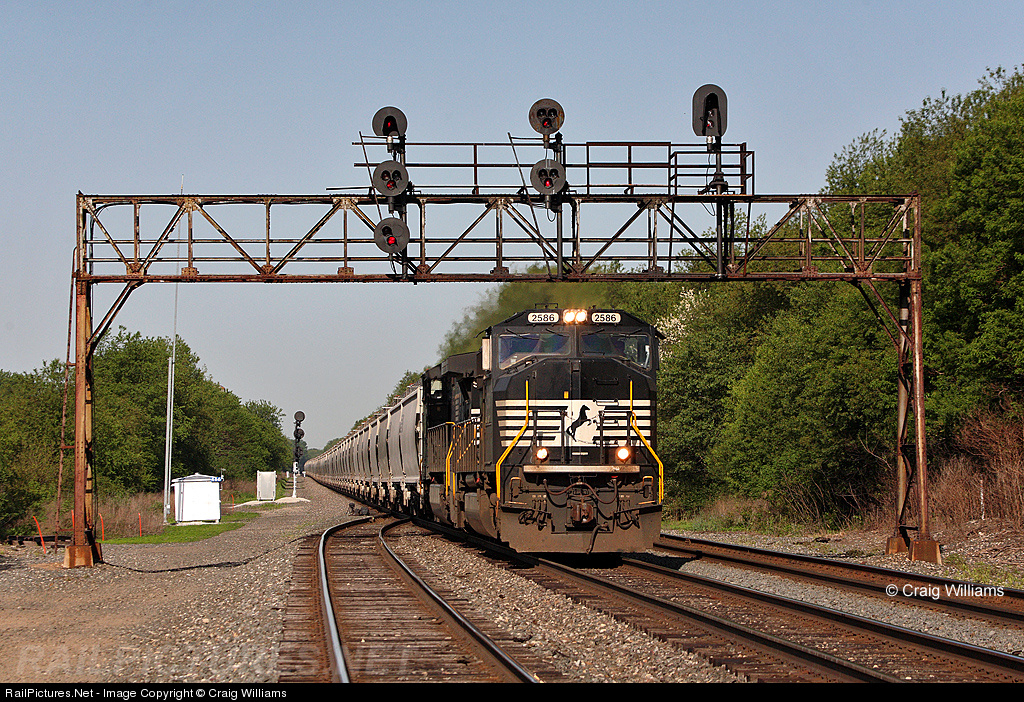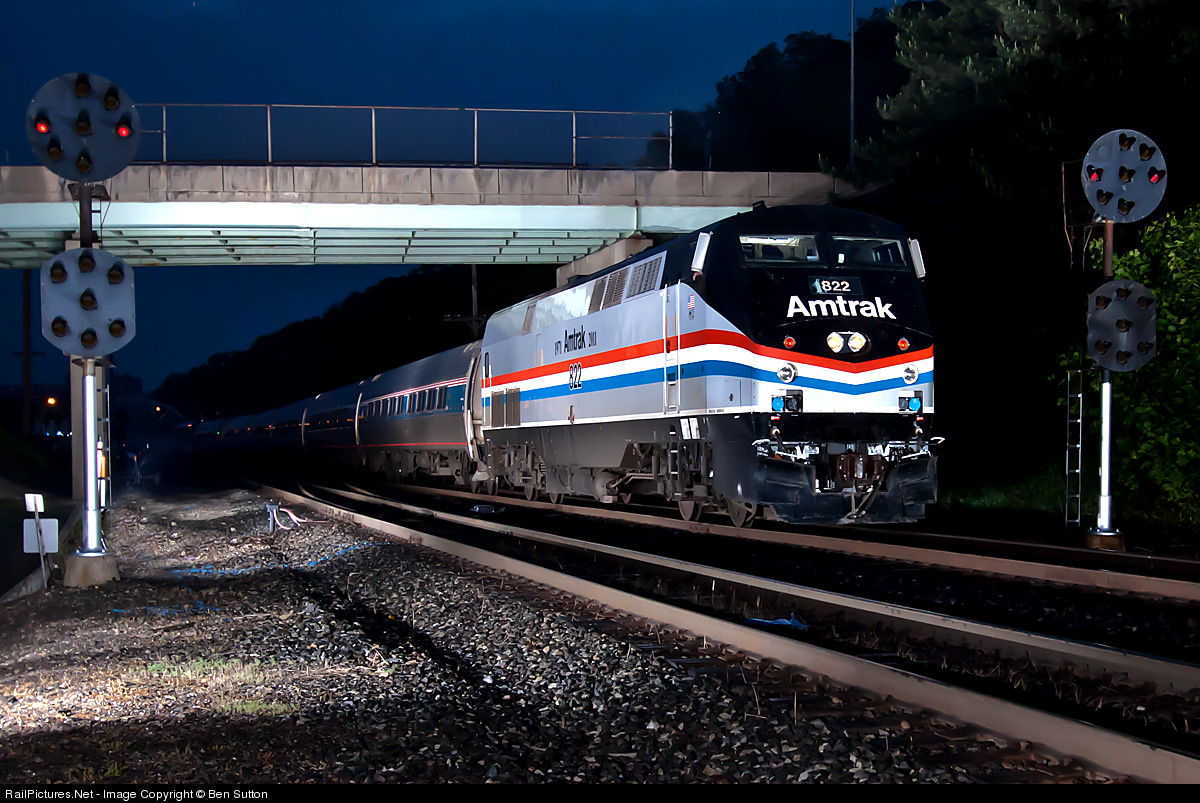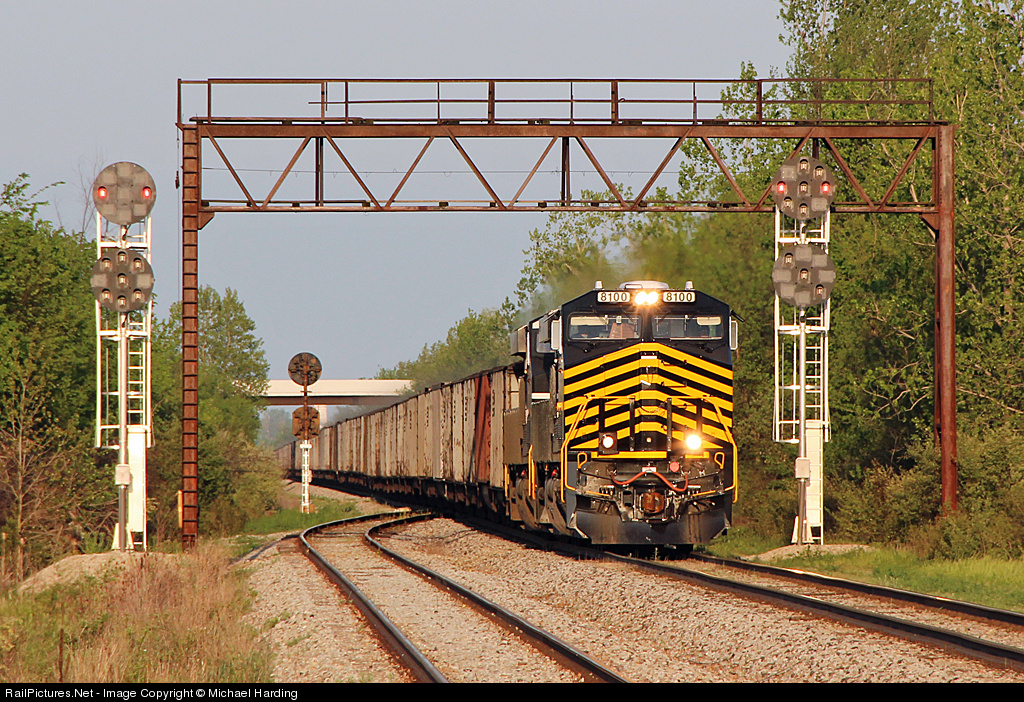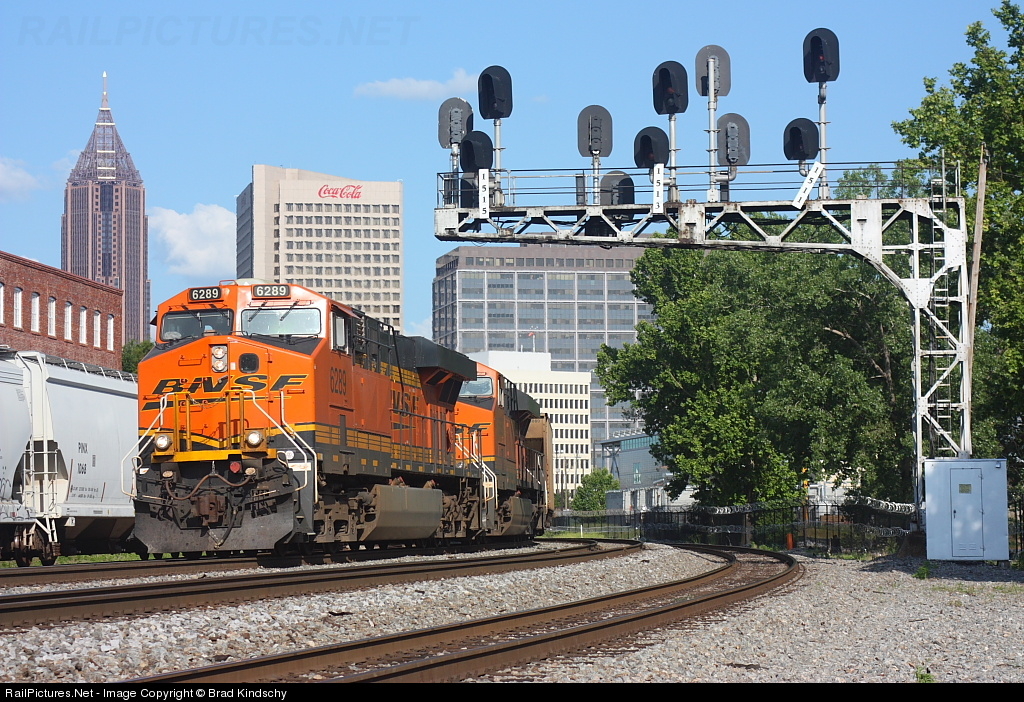I found a couple more examples of NS's more liberal policy of reusing older signaling hardware instead of just replacing it at the drop of a hat. First up is CP-466 on the Chicago Line where a classic New York Central signal gantry has been updated with a few NS style Darth Vaders, replacing one full head and a marker head, but leaving 4 "G" heads still intact.
The second is at CP-EAST PITT where NS has recently installed new electric switch machines to replace the ratty old ones and re-painted the bottom half of the PRR PL signal masts to give them a nice shine.
A blog devoted to explaining the ins and outs of North American railroad signaling, past, present and future. This blog seeks to preserve through photo documentation the great diversity and technical ingenuity of 20th century signaling and interlocking hardware and technology. Related topics cover interlocking towers and railroad communications infrastructure.
Note, due to a web hosting failure some of the photos and links may be unavailable.
Search This Blog
Monday, May 28, 2012
Tuesday, May 22, 2012
PRR Main Line Survey 2010 Part 13 (PAOLI to PENN)
In Part 11 we left off at PAOLI interlocking at the beginning of what is known as the Philadelphia Main Line which is a string of extremely wealthy communities that follow the Pennsylvania Railroad Main Line from the Philadelphia city line to Paoli (or arguable Malvern today). The wealth of these communities was directly attributable to the railroad as the transportation link allowed those with means to escape the dirty, smelly, congested downtown and trade it all in for plush suburban estates. During the gilded age the Railroad itself took on the role of real estate developer buying up land along its tracks and establishing several of what became the Main Line communities. Traffic on the Main Line became so intense that it was chosen in 1915 for the PRR's first experiment with high voltage AC overhead electrification as well as some of the earliest installations of Position Light signals due to a combination of fog and smoke risk as well as overhead wires obstructing sight lines.
This final section of the Main Line as we progress towards Philadelphia is almost completely untouched by re-signaling and functions today in roughly the same fashion as it did back in 1948. As always you can check out the 1992 diagram located here I have also included some photos taken in the fall of 2011 to replace any 2010 photos of inferior quality.
Now I have covered extensively in a previous post, so I have absolutely no intention of repeating myself, however due to the length of the interlocking I was unable to cover much of PAOLI's East End except by setting my camera's zoom to max. The East End begins with a standard 1915 era signal gantry holding the 24R, 26R and 28R signals and the 22R dwarf on the ground under it. In a bit of a historic quirk the 28R and 26R signals have a separate backing plate for the lower position light head. This was how the original PLs on this part of the line were installed back around 1915 with the lamp units set in front of detached black backings.
The 24L and 22L signals for westbound movements are set on a 1930's style of beam gantry and were probably installed when the plant was re-interlocked in the early 30's and the original electro-mechanical frame replaced with a US&S Model 14. The introduction of fully powered signaling allowed the construction of the East End facilities. Also visible are the 25 and 27 switches. The 25 is a 30 mph turnout used by trains on the express track to reach the Paoli Station platform. The slow speed 27 switch is somewhat strange in its placement and as such is barely used (as evidenced by the rust on the rails). It allows access to #2 track in the reverse (non-signaled) direction. What makes this stranger is that #3 track is actually bi-directional so it would be more logical for a facing switch from #2 to #3 in the East End, but this does not exist
However the East End continues on past the 22L/24L gantry, around a bend and finally to the 29 switch which allows trains on track #1 to go express on track #2 as my Amtrak train is shown doing. Note the reverse points, pneumatic point machine and secondary point detector.
Here we see the entire 29 turnout in all its reverse glory again with the pneumatic point machine and a back drive with attached point detector. In the foreground are the 26L and 28L dwarf signals which are both capable of displaying Slow Clear as PAOLI interlocking is bi-directionaly signaled on all 4 stacks between the east and wet ends.
Wider view showing the displacement between the 29 and 25/27 switches. This was to accommodate very long, long distance passenger trains platforming at Paoli that used to run way back in the day.
So just beyond the 29 switch we see an out of use signal gantry at about milepost 19. I mentioned that back in the day commuter traffic on this line was some of the most intense in the country. Both the steam hauled and later electrified trains weren't exactly sprightly by today's standards with speeds hovering between 30 and 50mph. As a result very close (about .5 mile) signaling was employed to minimize headways. Later block lengths were increased to 2 miles and speeds raised to 70 passenger, 50 freight.
This final section of the Main Line as we progress towards Philadelphia is almost completely untouched by re-signaling and functions today in roughly the same fashion as it did back in 1948. As always you can check out the 1992 diagram located here I have also included some photos taken in the fall of 2011 to replace any 2010 photos of inferior quality.
Now I have covered extensively in a previous post, so I have absolutely no intention of repeating myself, however due to the length of the interlocking I was unable to cover much of PAOLI's East End except by setting my camera's zoom to max. The East End begins with a standard 1915 era signal gantry holding the 24R, 26R and 28R signals and the 22R dwarf on the ground under it. In a bit of a historic quirk the 28R and 26R signals have a separate backing plate for the lower position light head. This was how the original PLs on this part of the line were installed back around 1915 with the lamp units set in front of detached black backings.
The 24L and 22L signals for westbound movements are set on a 1930's style of beam gantry and were probably installed when the plant was re-interlocked in the early 30's and the original electro-mechanical frame replaced with a US&S Model 14. The introduction of fully powered signaling allowed the construction of the East End facilities. Also visible are the 25 and 27 switches. The 25 is a 30 mph turnout used by trains on the express track to reach the Paoli Station platform. The slow speed 27 switch is somewhat strange in its placement and as such is barely used (as evidenced by the rust on the rails). It allows access to #2 track in the reverse (non-signaled) direction. What makes this stranger is that #3 track is actually bi-directional so it would be more logical for a facing switch from #2 to #3 in the East End, but this does not exist
However the East End continues on past the 22L/24L gantry, around a bend and finally to the 29 switch which allows trains on track #1 to go express on track #2 as my Amtrak train is shown doing. Note the reverse points, pneumatic point machine and secondary point detector.
Here we see the entire 29 turnout in all its reverse glory again with the pneumatic point machine and a back drive with attached point detector. In the foreground are the 26L and 28L dwarf signals which are both capable of displaying Slow Clear as PAOLI interlocking is bi-directionaly signaled on all 4 stacks between the east and wet ends.
Wider view showing the displacement between the 29 and 25/27 switches. This was to accommodate very long, long distance passenger trains platforming at Paoli that used to run way back in the day.
So just beyond the 29 switch we see an out of use signal gantry at about milepost 19. I mentioned that back in the day commuter traffic on this line was some of the most intense in the country. Both the steam hauled and later electrified trains weren't exactly sprightly by today's standards with speeds hovering between 30 and 50mph. As a result very close (about .5 mile) signaling was employed to minimize headways. Later block lengths were increased to 2 miles and speeds raised to 70 passenger, 50 freight.
Saturday, May 12, 2012
Now That's More Like It!
While the overall outlook for classic signaling is just this side of dismal, there are a few slight rays of hope. One of these was recently brought to my attention and consists of CP-EAST COLSON on the NS Fort Wayne Line. This interlocking which is of the same vintage (1980) as CP-ANTIS which is being replaced in the Altoona area, was recently suffering from a structurally failing classic PRR signal gantry. The typical NS play in this situation is to replace the gantry with some new cantilever with Darth Vader signals. Well not this time as NS installed two brand new PRR PL masts with LED lamp units. Why can't they do this more often!!
Hey, why stop here. I was reminded of another innovative use of old hardware by NS in the Atlanta area where a three track former Southern RR caltimever mast was re-used to support three pairs of two head Darth Vader automatic signals. They were even mounted with old school offset heads. Give another point to NS.
Well since three examples are a charm here we see a location (Pembroke) on the former N&W main where the old US&S style PL signals on an old bracket mast were recently replaced with brand new Safetran models. They are so new the mounting screws haven't had time to rust yet!
Hey, why stop here. I was reminded of another innovative use of old hardware by NS in the Atlanta area where a three track former Southern RR caltimever mast was re-used to support three pairs of two head Darth Vader automatic signals. They were even mounted with old school offset heads. Give another point to NS.
Well since three examples are a charm here we see a location (Pembroke) on the former N&W main where the old US&S style PL signals on an old bracket mast were recently replaced with brand new Safetran models. They are so new the mounting screws haven't had time to rust yet!
Wednesday, May 9, 2012
Game Over, Just Pack It In
Despite all the bad signal news those tho appreciate classic signaling could always count on the fact that classic signals were still being installed on a regular basis well into the 1980's and in some cases the 1990's. This was well into the solid state, microprocessor controlled era and those signals avoided the decades old relay logic and fragile pole lines that are now dooming so many early CTC installations. If signals typically last a good 40 to 50 years before replacement becomes a priority, that meant that at least these last in examples would be with us until the 2020's or even 2030's.
Unfortunately CSX has other ideas and case in point is the Capitol Sub between Baltimore and Washington. While there were some older interlockings, 7 were brand new from the 80's and 90's and as of now two have been resignaled (DORSEY and AMMENDALE) and two more, right outside of Washington Union Station, are about to go under the knife. That's right I'm talking about the back to back interlockings on the Washington Wye, F TOWER and QN TOWER.
F is known for its modern tubular cantilever mast with 2x4 orbital CPLs and its twin 6 orbital CPL masts (although the signals really only need 2 orbitals each). On the other side of things there is QN tower with its two 5 orbital and two 4 orbital CPL masts. This is going to be a real lost in an important railfan hotspot where both classic B&O and PRR position light signaling came together. What ever prompted CSX to go forward with this terrible waste I'll probably never find out, but the only option anyone really has right now is to get down there. QN is accessible from a bike path and F Tower can be viewed from a highway overpass from the rear of passing Amtrak trains.
Unfortunately CSX has other ideas and case in point is the Capitol Sub between Baltimore and Washington. While there were some older interlockings, 7 were brand new from the 80's and 90's and as of now two have been resignaled (DORSEY and AMMENDALE) and two more, right outside of Washington Union Station, are about to go under the knife. That's right I'm talking about the back to back interlockings on the Washington Wye, F TOWER and QN TOWER.
F is known for its modern tubular cantilever mast with 2x4 orbital CPLs and its twin 6 orbital CPL masts (although the signals really only need 2 orbitals each). On the other side of things there is QN tower with its two 5 orbital and two 4 orbital CPL masts. This is going to be a real lost in an important railfan hotspot where both classic B&O and PRR position light signaling came together. What ever prompted CSX to go forward with this terrible waste I'll probably never find out, but the only option anyone really has right now is to get down there. QN is accessible from a bike path and F Tower can be viewed from a highway overpass from the rear of passing Amtrak trains.
Subscribe to:
Posts (Atom)









